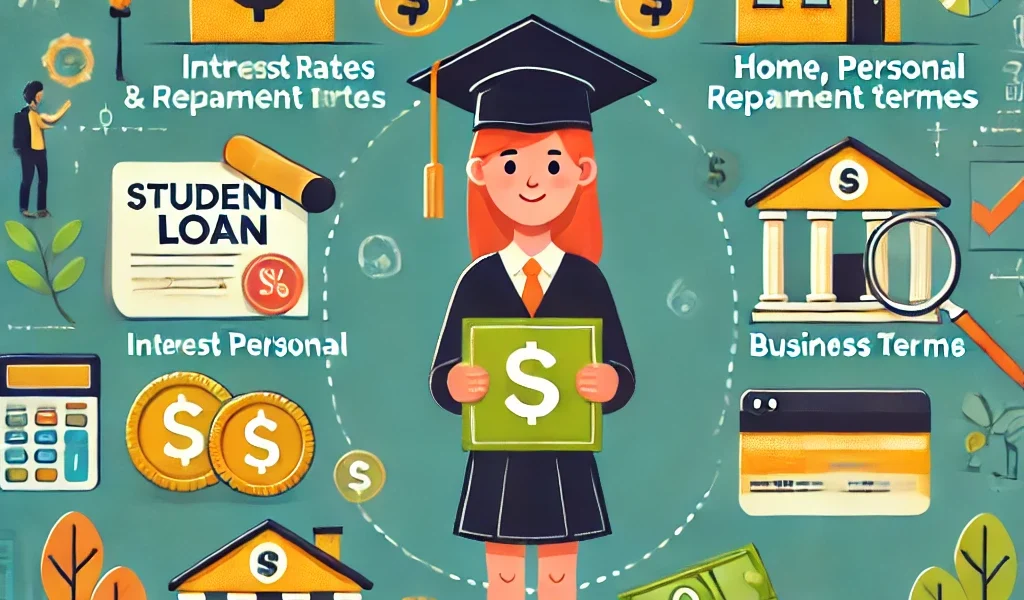Introduction
Education is one of the most significant investments individuals make in their lives, and student loans serve as a crucial financial tool for many aspiring students. Unlike other forms of loans, student loans come with unique policies, benefits, and repayment structures designed to accommodate the needs of students who may not have a steady income.
This article explores how student loan policies differ from personal, home, business, and auto loans, highlighting their features, eligibility criteria, repayment options, and associated benefits.
1. Key Differences Between Student Loans and Other Types of Loans
| Feature | Student Loans | Personal Loans | Home Loans | Business Loans | Auto Loans |
|---|---|---|---|---|---|
| Purpose | Education funding | General expenses | Home purchase | Business expansion | Vehicle purchase |
| Collateral Requirement | Usually unsecured | Unsecured | Secured (house) | Secured or unsecured | Secured (car) |
| Interest Rates | Lower rates, often subsidized | Higher, based on credit score | Lower due to collateral | Varies based on lender | Lower, fixed rates |
| Repayment Terms | Grace period, income-based repayment | Fixed EMIs | Monthly EMIs | Flexible based on business income | Monthly EMIs |
| Government Support | Yes, in many countries | No | Tax benefits | Subsidies in some cases | No |
| Loan Amount | Depends on tuition fees and living costs | Based on creditworthiness | Based on property value | Business needs and revenue | Based on vehicle price |
| Tax Benefits | Interest deductions available | No | Yes | Some cases | No |
2. Unique Features of Student Loan Policies
A. Lower Interest Rates and Government Subsidies
- Many governments offer subsidized student loans, where interest is paid by the government during the course period.
- Federal student loans (USA) typically have lower interest rates than personal or credit card loans.
- Education loan interest is tax-deductible in many countries.
B. Grace Period and Flexible Repayment Options
- Most student loans offer a grace period of 6 months to 1 year post-graduation before repayment starts.
- Some student loans have income-based repayment plans (IBR) that adjust EMIs based on income levels.
C. Loan Forgiveness and Deferment Options
- Certain student loans offer loan forgiveness programs for professionals in public service, teaching, or healthcare.
- Students facing financial hardships can apply for loan deferment or forbearance, delaying payments temporarily.
3. Eligibility Criteria for Student Loans vs. Other Loans
Student Loan Eligibility:
- Must be enrolled in an accredited institution.
- Requires a co-applicant (parent/guardian) for higher amounts.
- Good academic records may improve approval chances.
- Some loans require proof of admission or future earning potential.
Other Loan Types:
- Personal loans: Requires a strong credit score and steady income.
- Home loans: Requires property as collateral and high income stability.
- Business loans: Based on business revenue, credit history, and financial statements.
- Auto loans: Secured against the vehicle being purchased.
4. Student Loan Repayment Plans vs. Other Loan Repayments
Student loans come with flexible repayment options compared to other loans:
- Fixed Repayment Plan: Monthly EMIs remain constant.
- Graduated Repayment Plan: EMIs start low and increase over time.
- Income-Based Repayment (IBR): EMI is a percentage of income.
- Extended Repayment Plan: Longer tenure (up to 25 years) to reduce EMI.
By contrast, personal, business, and auto loans typically have fixed EMI structures with no income-based adjustments.
5. Pros and Cons of Student Loans Compared to Other Loans
✅ Advantages of Student Loans
✔ Lower interest rates. ✔ Flexible repayment terms. ✔ Government subsidies and tax benefits. ✔ Deferment and forgiveness options available. ✔ Builds credit history at an early age.
❌ Disadvantages of Student Loans
✖ Can lead to long-term debt if not managed properly. ✖ Limited to educational expenses. ✖ Not all programs qualify for loan forgiveness. ✖ Defaults can negatively impact credit scores.
6. How to Choose the Right Student Loan
When selecting a student loan, consider the following factors:
A. Interest Rate Type
- Fixed Rate: Stays the same throughout the loan tenure.
- Variable Rate: Fluctuates based on market conditions (riskier).
B. Government vs. Private Loans
- Government-backed loans have lower interest rates and flexible terms.
- Private loans may require higher credit scores and cosigners.
C. Repayment Flexibility
- Opt for loans that offer deferment, forbearance, or income-based repayment.
D. Additional Benefits
- Check for scholarships, grants, or employer tuition assistance programs before taking a loan.
Conclusion
Student loans differ significantly from other types of loans due to their low-interest rates, repayment flexibility, and government support. Unlike personal, home, or business loans, student loans are structured to accommodate the financial constraints of students, ensuring they can focus on education before starting repayment.
If you are planning to take a student loan, compare multiple options, consider government-backed schemes, and choose a repayment plan that aligns with your future income potential. Smart borrowing ensures that education remains an asset, not a financial burden!



